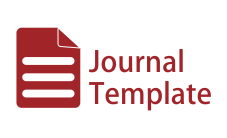Financial distress analysis at Bank Muamalat for 2016-2020
DOI:
https://doi.org/10.21580/jiemb.2022.4.1.11791Keywords:
financial distress, Bank Muamalat, monetary crisis, WCTA, RETA, EBITTA.Abstract
The monetary crisis that hit Southeast Asia has affected the financial condition of banks –including Islamic banks– so there is a potential for financial distress. The same thing was experienced by Bank Muamalat as the first sharia bank in Indonesia. This study aims to analyze the effect of the working capital ratio on total assets, retained earnings on total assets, profit before interest tax on total assets, and a book value of equity on the total book value of liabilities simultaneously on financial distress at Bank Muamalat. The method used is quantitative by using an analytical tool in the form of SPSS with a sample of Bank Muamalat. The results of this study indicate that Islamic banks on the ratio variables of WCTA, RETA, EBITTA and BVETL simultaneously have a significant effect on financial distress. This means that the ability of liquidity, profitability and solvency, as reflected in Altman’s four financial ratios if tested multivariate, will produce a reasonably accurate financial distress prediction from the influence of the four ratio variables. However, if tested univariately, some ratios will be dominant. Other ratios will become supporting ratios and state that 32-month banks are in category 1 (grey zone) and 28 months are in category 0 (stressed zone). This research implies that if the four components are combined in the bank test, there will be financial distress. To avoid financial distress, all components must be maintained both in terms of operations, resources and financial condition (distress zone).
Keywords: financial distress; Bank Muamalat; monetary crisis; WCTA; RETA; EBITTA.
Downloads
References
Ali, M. D. (1988). Sistem Ekonomi Islam: Zakāt dan Wakaf (1st ed.). Jakarta: Universitas Indonesia.
Andriyanto, I. (2011). Strategi Pengelolaan Zakāt dalam Pengentasan Kemiskinan. Walisongo: Jurnal Penelitian Sosial Keagamaan, 19(1), 25–46. https://doi.org/10.21580/WS.19.1.211
Badan Pusat Statistik. (n.d.). Jumlah Penduduk Miskin Menurut Provinsi, 2007-2020. Retrieved February 7, 2021, from https://www.bps.go.id/linkTableDinamis/view/id/1119
Bahri, E. S., & Arif, Z. (2020). Analisis Efektivitas Penyaluran Zakāt pada Rumah Zakat. Al Maal: Journal of Islamic Economics and Banking, 2(1), 13–24. https://doi.org/10.31000/ALMAAL.V2I1.2642
Haidir, M. S. (2019). Revitalisasi Pendistribusian Zakāt Produktif Sebagai Upaya Pengentasan Kemiskinan di Era Modern. Muqtasid: Jurnal Ekonomi Dan Perbankan Syariah, 10(1), 57. https://doi.org/10.18326/muqtasid.v10i1.57-68
Karim, A. (2013). Ekonomi Makro Islami (2nd ed.). Jakarta: Rajawali Pers.
Lessy, Z. (2013). Philanthropic Zakāt for Empowering Indonesia’s Poor: A Qualitative Study of Recipient Experiences at Rumah Zakat. Indiana University.
Maulana, M. I., Rahman, A., & Setiawan, A. I. (2019). Implementasi Pendistribusian Zakāt Produktif dalam Meningkatkan Ekonomi Masyarakat. Tadbir: Jurnal Manajemen Dakwah, 4(1), 97–114. https://doi.org/10.15575/tadbir
Mufraini, M. A. (2006). Akuntansi dan Manajemen Zakāt (1st ed.). Jakarta: Kencana Prenada Media Group.
Muhammad, & Bakar, A. (2011). Manajemen Organisasi Zakāt. Malang: Madani.
Muhtada, D. (2008). The Role of Zakāt Organization in Empowering the Peasantry: A Case Study of the Rumah Zakat Yogyakarta Indonesia. In M. Obaidullah & H. S. H. A. Latif (Eds.), Islamic Finance for Micro and Medium Enterprises (pp. 289–310). Islamic Research & Training Institute Islamic Development Bank and Centre for Islamic Banking, Finance and Management Universiti Brunei Darussalam.
Mursyidi. (2008). Akuntansi Zakāt Kontemporer (5th ed.). Bandung: PT. Remaja Rosdakarya.
Nurnaningsih. (2020). Rumah Zakat Cabang Semarang 2006-2017: Perkembangan Sebuah Lembaga Filantropi dan Peranannya dalam Pemberdayaan Masyarakat. Fakultas Ilmu Budaya Universitas Diponegoro.
Puskas Baznas. (2020). Outlook Zakāt Indonesia 2020. Jakarta: Pusat Kajian Strategis BAZNAS.
Raco, J. R. (2010). Metode Penelitian Kualitatif: Jenis, Karakteristik, dan Keunggulannya. Jakarta: PT. Grasindo.
Rumah Zakat. (2020). Annual Report Rumah Zakat 2020.
Sejarah - Rumah Zakat. (n.d.). Retrieved February 7, 2021, from https://www.rumahzakāt.org/id/tentang-kami/sejarah
Syahriza, M., Harahap, P., & Fuad, Z. (2021). Analisis Efektivitas Distribusi Zakāt Produktif Dalam Meningkatkan Kesejahteraan Mustahik (Studi Kantor Cabang Rumah Zakat Sumatera Utara). At-Tawassuth: Jurnal Ekonomi Islam, 4(1), 137–159. https://doi.org/10.30829/AJEI.V4I1.4090
Syaksena, A., & Ekawaty, M. (2021). Effect of zakāt (almsgiving) literacy level on muzakki’s decision to pay zakāt in registered zakāt institutions. Journal of Islamic Economics, Management, and Business (JIEMB), 3(1), 15–34. https://doi.org/10.21580/JIEMB.2021.3.1.8841
Syarifah, L. (2021). The utilization of zakāt for improving economic growth in Indonesia (case study at BAZNAS of Kendal regency). Journal of Islamic Economics, Management, and Business (JIEMB), 3(1), 73–88. https://doi.org/10.21580/JIEMB.2021.3.1.8948
Tentang kami - Rumah Zakat. (n.d.). Retrieved February 7, 2021, from https://www.rumahzakāt.org/id/tentang-kami
Tohirin. (2012). Metode Penelitian Kualitatif dalam Pendidikan dan Bimbingan Konseling. Jakarta: Raja Grafindo Persada.
Toriquddin, M. (2015). Pengelolaan Zakāt Produktif di Rumah Zakat Kota Malang: Perspektif Maqasid al-Syariah Ibnu ‘Asyur. Ulul Albab: Jurnal Studi Islam, 16(1), 62–79. https://doi.org/10.18860/UA.V16I1.2839
Undang-Undang RI Indonesia. (2011). Undang-Undang Republik Indonesia Nomor 23 Tahun 2011 Tentang Pengelolaan Zakāt. Jakarta.
Yuliafitri, I., & Khoiriyah, A. N. (2016). Pengaruh Kepuasan Muzakki, Transparansi dan Akuntabilitas Pada Lembaga Amil Zakāt Terhadap Loyalitas Muzakki (Studi Persepsi Pada LAZ Rumah Zakat). ISLAMICONOMIC: Jurnal Ekonomi Islam, 7(2). https://doi.org/10.32678/IJEI.V7I2.41
Interview with Muhammad Isa, Branch Manager of Rumah Zakat Semarang, 29th of September, 2020
Interview with Ida Aniyati, Finance Service Officer of Rumah Zakat Semarang, 29th of September, 2020
Interview with Puji Purnomo, Head of Utilization Division of Rumah Zakat Semarang, 29th of September, 2020
Downloads
Published
Issue
Section
License
Authors who publish with this journal agree to the following terms:
Authors retain copyright and grant the journal right of first publication with the work simultaneously licensed under a Creative Commons Attribution-ShareAlike 4.0 International License that allows others to share the work with an acknowledgement of the work's authorship and initial publication in this journal.
Authors are able to enter into separate, additional contractual arrangements for the non-exclusive distribution of the journal's published version of the work (e.g., post it to an institutional repository or publish it in a book), with an acknowledgement of its initial publication in this journal.
Authors are permitted and encouraged to post their work online (e.g., in institutional repositories or on their website) prior to and during the submission process, as it can lead to productive exchanges, as well as earlier and greater citation of published work (See The Effect of Open Access).


